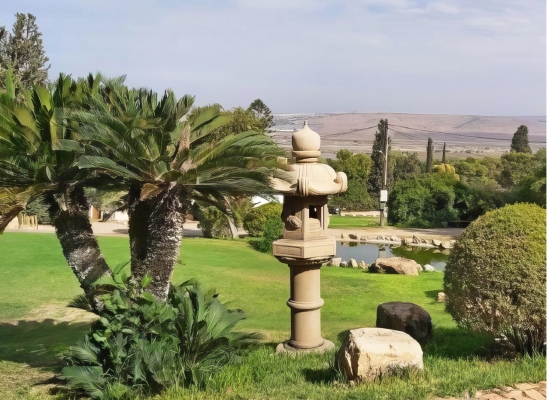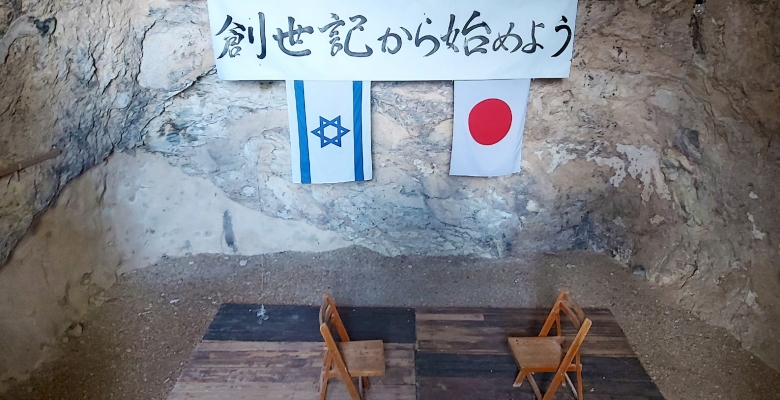Makuya – A Corner of Japan in Israel
Text & Photos: Lydia Aisenberg
Snuggly tucked into the folds of the lower slopes of the Gilboa mountain range, at the highest point of the sprawling kibbutz of Heftzibah, sits an inviting small green paradise in the form of a Japanese garden. The garden stands out starkly from the almost treeless, dry, grey rocky face of the craggy mountains behind – the site where Saul, the first King of Israel and his three sons lost their lives battling Philistines.
Kibbutz Heftzibah, founded in 1922, is perched on the zig-zag boundary line between the Jezreel valley and the Harod and Beit Shean valleys, abundant with spring water. In the early 1960s, members began developing an extraordinarily close relationship with a Japanese movement known as the Makuya, founded by Professor Avraham Ikuro Teshima shortly after Israel's declaration of independence in 1948, which the professor described as being "the greatest miracle of the twentieth century".
Professor Teshima believed, and passed on that belief to thousands of Japanese followers since founding the Makuya, that the establishment of the State of Israel, and later reunification of Jerusalem 20 years later, was the fulfillment of biblical prophecies.
Over the years, except during the Covid pandemic, hundreds of members of the movement have attended the Heftzibah ulpan as well as study centers in other kibbutzim in the Jezreel Valley. The young, and sometimes not-so-young, Japanese visitors study Hebrew and the history of Israel, tour the land and also toil in the soil alongside members of the kibbutzim. The majority of these kibbutzim were socialist-based collectives until two decades ago, when many were privatized, including Heftzibah.
A thousand or more Makuya followers have also gone on to study at Israeli universities and other centers of learning. The most popular subjects are Biblical studies, Jewish history, religion, the Hebrew language and archaeology. Hundreds more are graduating from classes and specialized courses taught at the Makuya center in Jerusalem.
As a mark of their appreciation to the folks of Kibbutz Heftzibah, where Makuya movement adherents have always felt particularly at home, the followers of Professor Teshima (1910-1973) built an impressive Makuya meeting center and Japanese garden on the hill above the kibbutz. The quiet, aesthetically rich garden, situated literally in the shadow of the Gilboa mountains that loom above and behind, evokes positive emotions.
Professor Teshima, a successful businessman, was a religious Christian who had become disillusioned with the established church. He founded the Makuya in the belief that to be able to find the true spirit of the Bible, one had to be able to understand deeply the faith of the Jewish people, their history, thought and language.
After a chance meeting in the mid-1950s with a number of Israelis during a train journey in Japan, Professor Teshima corresponded for some years with one of those fellow passengers, an Israeli academic. In 1961 he undertook his first journey to Israel, during which he was extremely impressed by the pioneer kibbutz members that he met. He returned to Japan with the conviction that the very soul of Judaism was not only alive, but actually thriving!
Every year, organized by the Christian Embassy in Jerusalem, thousands of Christian supporters of Israel from all over the world celebrate the Feast of Tabernacles by marching through the streets of Jerusalem, each group bearing flags from their countries, many in national costumes. The Makuya are always among the most joyous, waving Israeli and Japanese flags and adorned in their distinctive blue and white Makuya waistcoats, singing Israeli songs.
The small, meticulously cared-for Japanese garden on the hill at Heftzibah is dotted with Japanese sculptures, deep green well-clipped lawns, dark and light green artistically fashioned bushes, a small waterfall and a pond filled with Koi fish – all oozing tranquility. Visitors to the garden feel an instant embrace from an invisible, totally peaceful, soothing presence and an open invitation to connect with the abundant nature all around.
A large cave carved out from the rock face, with wide steps going down into its depths, contains two wooden folding chairs facing each other on a large wicker mat in the center, and a few banners with Biblical quotations in Japanese and Hebrew stretched across the walls around. The cave is a place for quiet contemplation, with rays of sunshine penetrating through, creating a natural spotlight and aura.
On the corner of the building, an engraved wooden plaque in both Hebrew and Japanese simply states: Beit Makuya – the House of Makuya. Here every Friday the incumbent group of Japanese students invite locals and guests to join them for Kabbalat Shabbat.
An absolute made-to-measure corner of welcoming quiet and beauty to take time out from the turbulent, frightening and on-going horrors of the Israel-Hamas war raging in the south and Israel-Hezbollah conflict on the northern border with Lebanon.









Comments